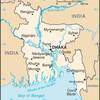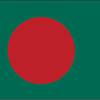Bangladesh [+]Compare [E]dit [H]istory
Aliases: East Bengal, East Pakistan, Gana Prajatantri Bangladesh, People's Republic of BangladeshObject «Bangladesh» was created due to
Add new object to «Bangladesh» or move existing objects here.
Object «Bangladesh» has attributes [Show empty attributes][Hide empty attributes]
| Attribute | Value |
|---|---|
| Geography | |
| Area | 148,460 km² |
| Continent | Asia |
| Land area | 130,170 km² |
| Water area | 18,290 km² |
| Land boundaries | 4,413 km |
| Border countries |
|
| Coastline | 580 km |
| Mean elevation | 85 m |
| Lowest point | 0 m |
| Highest point | 1,230 m |
| People | |
| Population | 162,650,853 |
| Official languages |
|
| Religion | Muslim |
| Government | |
| Long country name | People's Republic of Bangladesh |
| Short country name | Bangladesh |
| Long local name | Gana Prajatantri Bangladesh |
| Short local name | Bangladesh |
| Former name |
|
| Government type | Parliamentary republic |
| Capital | Dhaka |
| Economy | |
| GDP (PPP) | 690,300,000,000 USD |
| GDP (OER) | 261,500,000,000 USD |
| GDP (real growth rate) | 7.4 % |
| GDP - per capita (PPP) | 4,200 USD |
| Gross national saving | 30.2 % of GDP |
| Labor force | 66,640,000 |
| Unemployment rate | 4.4 % |
| Population below poverty line | 24.3 % |
| Budget revenues | 25,100,000,000 USD |
| Budget expenditures | 33,500,000,000 USD |
| Military expenditures | 1.37 % of GDP |
| Taxes and other revenues | 9.6 % of GDP |
| Budget surplus or deficit | -3.2 % of GDP |
| Public debt | 33.1 % of GDP |
| Inflation rate | 5.6 % |
| Central bank discount rate | 5 % |
| Commercial bank prime lending rate | 9.54 % |
| Stock of narrow money | 28,680,000,000 USD |
| Stock of broad money | 28,680,000,000 USD |
| Stock of domestic credit | 152,100,000,000 USD |
| Market value of publicly traded shares | 92,330,000,000 USD |
| Current account balance | -5,322,000,000 USD |
| Exports | 35,300,000,000 USD |
| Imports | 47,560,000,000 USD |
| Reserves of foreign exchange and gold | 33,420,000,000 USD |
| External debt | 50,260,000,000 USD |
| National currency | taka |
| National currency (code) | BDT |
| National currency (symbol) | ৳ |
| National currency rate to USD | 80.69 |
The huge delta region formed at the confluence of the Ganges and Brahmaputra River systems - now referred to as Bangladesh - was a loosely incorporated outpost of various empires centered on the Gangetic plain for much of the first millennium A.D. Muslim conversions and settlement in the region began in the 10th century, primarily from Arab and Persian traders and preachers. Europeans established trading posts in the area in the 16th century. Eventually the area known as Bengal, primarily Hindu in the western section and mostly Muslim in the eastern half, became part of British India. Partition in 1947 resulted in an eastern wing of Pakistan in the Muslim-majority area, which became East Pakistan. Calls for greater autonomy and animosity between the eastern and western wings of Pakistan led to a Bengali independence movement. That movement, led by the Awami League (AL) and supported by India, won the independence war for Bangladesh in 1971. The post-independence AL government faced daunting challenges and in 1975 was overthrown by the military, triggering a series of military coups that resulted in a military-backed government and subsequent creation of the Bangladesh Nationalist Party (BNP) in 1978. That government also ended in a coup in 1981, followed by military-backed rule until democratic elections occurred in 1991. The BNP and AL have alternated in power since 1991, with the exception of a military-backed, emergency caretaker regime that suspended parliamentary elections planned for January 2007 in an effort to reform the political system and root out corruption. That government returned the country to fully democratic rule in December 2008 with the election of the AL and Prime Minister Sheikh HASINA. In January 2014, the incumbent AL won the national election by an overwhelming majority after the BNP boycotted, extending HASINA's term as prime minister. In December 2018, HASINA secured a third consecutive term (fourth overall) with the Awami League coalition securing 96% of available seats, amid widespread claims of election irregularities. With the help of international development assistance, Bangladesh has reduced the poverty rate from over half of the population to less than a third, achieved Millennium Development Goals for maternal and child health, and made great progress in food security since independence. The economy has grown at an annual average of about 6% over the last two decades and the country reached World Bank lower-middle income status in 2014.
Similar objects
Most often compared with
Everyone can something to edit or add.
There was one edit, no edits waiting approval. Last edited by jmcdermott(9391), Sep 15, 2019 (65 fields were changed)
Help · Contact us · Disclaimer · Contributors · Developers · Donate


